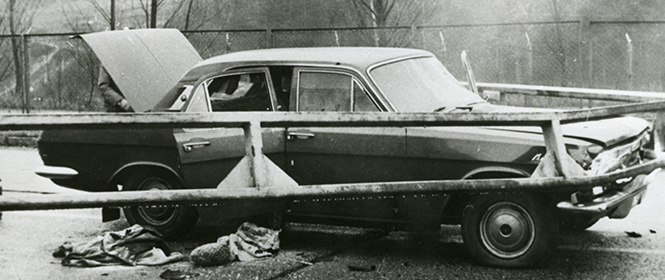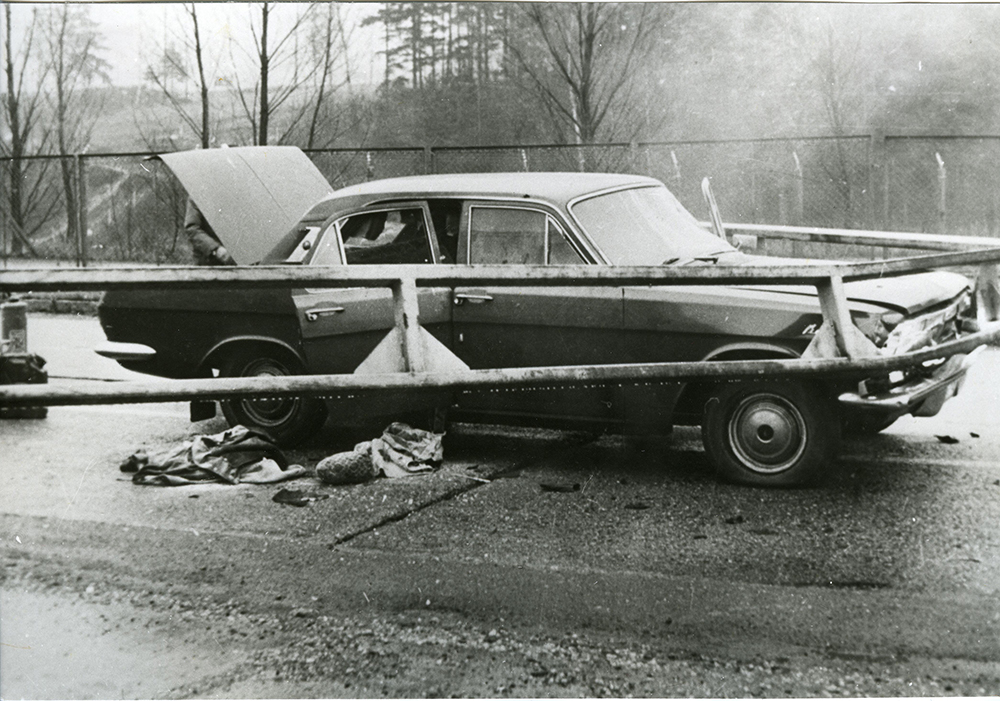
‘An attempt at wishful thinking, all it did was create a sense of fear.’
Unusual Occurrences – Thirty Years Ago Today | Part 4
Zsuzsa Breier | 6 November 2019
The year 1989 has gone down as the most seismic in post-war European history. In four exclusive pre-publication extracts from her book, diplomat and literary scholar Zsuzsa Breier offers insights into the rapid developments in Germany and Hungary thirty years ago.
‘Horrible day,’ Walter Kempowski noted on 1 April 1989, writing in what he described as his ‘hermetic confinement’ in the north German village of Nartum (which his south German mother-in-law viewed as ‘the sticks up north’). ‘But at least no one’s played an April Fool on me,’ Kempowski wrote. Nonetheless, the day was not lacking in curious events:
Hildegard comes in crying, with two songbirds in the dustpan. Considering the six million songbirds trapped every year in the South, her sorrow seemed odd…[1]
Kempowski, the self-described ‘German chronicler’ had undertaken to write a ‘collective diary’ of the Second World War, entitled Echolot (Sonar). From as early as 1980, Kempowski had collected huge amounts of material. But the larger his ‘Archive of Unpublished Autobiographies’ grew, the greater the doubts of his publisher, Albrecht Knaus, about the sheer manageability of the material. In response, Kempowski only said: ‘It takes the entire cornfield to reveal the wind – not a single stalk.’
Kempowski’s unwavering resolution was still affected by his years in Bautzen: perhaps it was this he meant when he used the curious phrase ‘Bautzen was a blessing for me’. Kempowski was incarcerated in the East German prison of Bautzen at the age of nineteen, and went on to serve eight years there, after having been arrested while visiting his mother in Rostock, having come from Hamburg (in the West), where he lived at the time. A Soviet military tribunal sentenced him to 25 years hard labour, finding him guilty of espionage, anti-Soviet agitation, unlawful border-crossing and unlawful assembly. Between 1948 and 1956 – the years Kempowski spent at Speziallager Nr.4 – around 3000 prisoners died within the confines of the notorious prison camp. Perhaps by ‘Bautzen was a blessing for me’, Kempowski was referring to the deaths, since he survived his imprisonment and was even permitted to leave the GDR, weighing just 45 kilos. Nonetheless, he would say that while hunger, cold, isolation cells and sleep deprivation can gnaw away at the body, the spiritual deprivation was even worse. This probably prompted his first written words after leaving prison – I AM FREE (written in capitals). It was impossible for him to think of anything greater than this.
Thirty-three years later, on 1 March 1989, Kempowski was watching a programme about East Germany on West German television. He found it even stranger than Hildegarde with her feelings for song birds:
Incredible programme about a village in Mecklenburg. That the people there are very happy with their existence on the collectivized farm. I turned it off as quickly as possible. An attempt at wishful thinking, all it did was create a sense of fear.[2]
At just that time, near the town of Boltenhagen, some 200 kilometres northwest of Nartum, a family was learning all about that sense of fear, as their fate was sealed by the binoculars, compass, fuel canisters and documents that had been found on them. Their journey had been intended to look like a family outing, but the Stasi was on high alert:
Pre-emptive prevention of illegal departure from the GDR by means of inflatable boat over the Baltic Sea, to be committed by a married couple accompanied by their three children (ages 5, 6 and 11)…
The perpetrators used their Wartburg car to transport an inflatable boat with outboard engine, canisters containing 35 litres of engine fuel, a compass, a pair of binoculars and various personal documents, including professional certificates. Investigations continue.[3]
On the Berlin to Budapest train, another GDR citizen seeking to flee the country met his downfall in the form of a missing document and a ‘deer catcher’ hunting knife, usually used to finish off wounded game on shooting expeditions:
On 31 March 1989 at 11.15 a.m., aboard an international train (Berlin–Budapest) at crossing point Bad Schandau, GDR passport control officers succeeded in arresting a Leading Seaman of the People’s Navy (18 years old, torpedoman XX, coastal defence vessel section XX), having found him not to be in possession of the documents required to holiday in a foreign country.
The perpetrator intended to travel to the Czechoslovak Socialist Republic, and from there to desert and travel to the Federal Republic of Germany [FRG].
He had with him a duffel bag containing a black workman’s outfit, leather gloves, a hunting knife and a compass…
An investigation has been launched and an arrest warrant issued.[4]
On the evening which saw the happiness of East German collective farmers broadcast on West German television, three ‘disaffected’ GDR citizens attempted a ‘forcible’ breach of the border at Drewitz:
On 31 March 1989 at 11.53 p.m., three persons attempted… to forcibly break through Drewitz border crossing point in a car of the ‘Saporoshez’ model, intending to reach West Berlin.
To this end, they drove the car at high speed past the guard post and checkpoint, into the border crossing area itself. The alarm was immediately sounded, resulting in the activation of barriers and other security devices. Approximately 250 metres after passing the guard post, the car was brought to a halt… by a barrier cable which had meanwhile been pulled tight. The perpetrators were arrested uninjured… Western media have reported on the incident.[5]

Gescheiterter Fluchtversuch im Auto von Ost- nach West-Deutschland, um 1975, Deutsche Demokratische Republik © DHM
Western media reported on events that were visible from the West. Comparable incidents which they did not see were kept ‘top secret’, with information made available only to the Ministry of State Security (the Stasi) and leading members of the ruling Socialist Unity Party (SED). The information did not, however, prompt these senior figures to consider changing their policies.
In the period from 27 March to 2 April, a total of 78 GDR citizens were arrested (previous week: 52)…, of which 77 (previous week: 52) were accused of preparing or attempting to illegally cross the borders of the state, among them 34 (previous week: 10) who attempted to do so by misusing the territory of other socialist states.[6]
In that first weekend in April, Hegyeshalom, a Hungarian crossing point at the Austrian border, was in a high state of alert. It was shortly before 4 April, the day marking the Red Army’s ‘liberation’ of Hungary – this was the official term used, although Hungarians themselves spoke of an occupation. But by now even the Party – via a Central Committee decision on 11 February 1989 – had recognized the Hungarian Uprising of autumn 1956, the most famous resistance to the Soviet occupation, to be a ‘people’s revolt’ (re-appropriating a stock phrase of Bolshevism and turning it against the Russians). Clearly, the official liberation rhetoric could no longer be used on 4 April. No one was inclined to celebrate 4 April in the usual way, with official wreath-laying and medal ceremonies. In any case, the holiday had never been celebrated with anything like the fervour associated with 15 March or 23 October, dates marking the 1848 March Revolution and the 1956 Uprising respectively. Nonetheless, this year’s Liberation Day was widely greeted as a stroke of good luck, since it fell on a Tuesday, meaning people could also take the Monday off. This led to a substantial proportion of the working population getting in their cars to head for the Austrian border, if possible bringing the grandparents along, to increase the amount of currency they could exchange. There were limits on how many forints a person could change into hard foreign currency: in 1988, the official allowance had been set at US$60 per person. Anything over that amount – often Deutschmarks privately swapped with West German tourists at Lake Balaton – was safely hidden away in grandma’s socks.
Those heading for the border also had to take along their ‘world passport’. Since 1 January 1988, this document could be obtained by all Hungarians, except for a few thousand ‘enemy elements’ and figures otherwise regarded as dangerous. (Thus, for example, opposition politician Ferenc Köszeg found himself without a ‘world passport’.) In the first half-year, half a million such passports had been issued; and by April 1989 the number of Hungarian passport holders was in the millions. On these two blissfully workfree spring days, most of the ‘world passports’ would finally be put to use in making the crossing to Austria. On the day, the sky was overcast and, ironically, the west of Hungary also saw some rain. But this stopped no one, and soon the crowds at the western border were almost uncontrollable, a traffic jam of half a million Hungarians. Travelling into Austria, they were not set on seeing the Stephansdom in Vienna or making the famed pilgrimage to the Mariazell Basilica: those sights could be seen on a Sunday. On a weekday, it was all about the shopping, as the final socialist ‘Liberation Day’ (by the following year, the holiday would no longer exist) became a two-day ‘festival of VCRs and coolboxes’:
According to information from the border police, the majority of tourists who went to Austria to shop returned to Hungary in the early morning hours. More than 200,000 people passed across the border and back…
On the Austrian side, women held protests, demanding that the authorities take measures to ensure the safety of their children, since the heavy traffic meant it was almost impossible to cross local roads on foot.[7]
In the year leading up to this, Hungarian shoppers had spent some 50 billion forints just between the border town of Nickelsdorf and the capital Vienna. Hungary’s foreign currency reserves nosedived accordingly. Two months before, in the GDR, Chris Gueffroy had been shot and killed by a border security guard while trying to flee the country. Just a month previously, Winfried Freudenberg’s hot-air balloon escape attempt had ended fatally. In short, ‘discontent with social conditions’ in the Eastern Bloc was becoming more and more apparent, in spite of strict secrecy and the occasional optimistic report broadcast on Western television.
Between 3 April and 9 April, there had been ‘66 arrests for offenses related to preparing for or attempting to illegally leave the GDR’. By the end of April, that weekly total had reached 93. At the end of March, the Stasi counted 147 successful illegal attempts to leave the GDR, while by the final week of April, that total had already hit 192.[8]
The Stasi still managed to deal with the ongoing embassy occupations in Prague, Warsaw and Budapest as discreetly as possible, but the sheer number of those who were, in their words, ‘criminally misusing the territory of other socialist states’ was becoming less and less manageable:
In the week from 3 April to 7 April 1989, 30 GDR citizens (previous week: 33) were staying at West Germany’s Permanent Representation in the GDR (12 in total), as well as the West German embassies in Prague (15) and Budapest (3), all intent on forcing their permanent resettlement in West Berlin or the FRG. Since 2 January 1989, therefore, the number of blackmailers has increased to a grand total of 794…
The majority departed from the FRG’s diplomatic missions, after having been promised a ‘positive solution’ to their applications for permanent emigration and resettlement.[9]
In Budapest, the government had other matters to deal with. For months, the Interior Ministry had been trying to make good on the government’s promise to return the remains of the leaders of the 1956 Uprising, executed two years later, to their families. But there was a problem – apparently no one now knew the precise location of the bodies, which had been buried in unmarked graves after torture and execution. The government had come under pressure from the families of the dead and from the Commission for Historical Justice, as well as from a demonstration of 400 people, held on 16 June 1988, the 30th anniversary of the executions. The gathering was violently broken up by police, with fifteen arrests. Eventually, in the summer of 1988, party leader Grósz made a promise to give the bodies a proper burial. But to do that, they first had to be found.
The first attempt failed. József Pajcsics, a secret service agent entrusted with the ultra-confidential mission, searched through archived folders and card files, and on several occasions combed the cemetery’s overgrown section 301 for traces or clues of possible gravesites, finally reporting back:
The graves were not found, and cannot be found. Mission could not be completed.[10]
However, a conspiratorial secret dossier, tellingly entitled Wasps’ Nest, was indeed finally located in a safe at the Interior Ministry. This provided the all gruesome details of the executions and what was later done with the bodies. After the executions, under cover of night, the men’s corpses had been buried in the prison yard, and covered with rubble, discarded furniture and rubbish. Two years later, reported the file, a highly secret reburial took place in section 301, again carried out in the dead of night. Details were included on the distance, measured out in steps, between the graves and the cemetery wall. The excavation of the site could now begin.
On Wednesday April 5, after five days of excavations at the cemetery, the graves were finally discovered. We were able to locate what are thought to be the remains of all the martyrs.[11]
Standing beside the graves were the families of the victims (now strikingly renamed ‘martyrs’): widows, children and grandchildren. Also present were forensic scientists, anthropologists, interior secretary Borics and Colonel Pajcsics, as well as an archaeologist thought to be an expert in Hungarian royal graves. But there was no press and no publicity. Apart from the Interior Ministry’s cameras, the only other images were taken by the Hungarian film director Judit Ember, working on behalf of the families. Her lenses captured an unfathomable reality: beneath the earth were bodies with hands and feet bound with wire, partly thrown on top of each other, wrapped in tar paper, their skulls penetrated by tree roots. Even after death, the bodies had been repeatedly ill-treated and defiled, put face down into the grave rather than face up, as normal. There are simply no words for the pain of saying farewell to such corpses, of being permitted to exhume and rebury them – even while the country was on the verge of achieving hopes that had been nurtured in secret for decades.
Sources
1 Kempowski, Alkor (2001), 151.
2 Ibid., 154.
3 BStU, MfS, ZAIG 4593, 11f.
4 Ibid., 9.
5 Ibid., 11.
6 Ibid., 10.
7 osa, hung.mon. 4.4./89, 189, 190.
8 Ibid., 40, 44, 96.
9 MfS ZKG 19261, 16.
10 Pajcsics, A 301-es parcella titkai (Secrets of Section 301).
11 http://tausz.tripod.com/sajto.htm
 © Uwe Steinert |
Dr. phil. Zsuzsa BreierBorn in Budapest in 1963. Studied literature and cultural studies at Eötvös Loránd University, taught modern German literature at her home university and cultural management at Berlin’s Humboldt University, joined the diplomatic service in 2004, organized the “Kulturjahr der Zehn“ [Cultural Year of the Ten], and founded the “Gesellschaft zur Förderung der Kultur im erweiterten Europa” [Society for the promotion of culture in extended Europe] and published the anthology “Freiheit, ach Freiheit…“ [Freedom, oh freedom …]. In 2012, she was appointed Secretary of State for European Affairs by the Hessian state government. In 2015, she headed the Handelsblatt Global Edition. Since 2016, she has been researching the year 1989. |